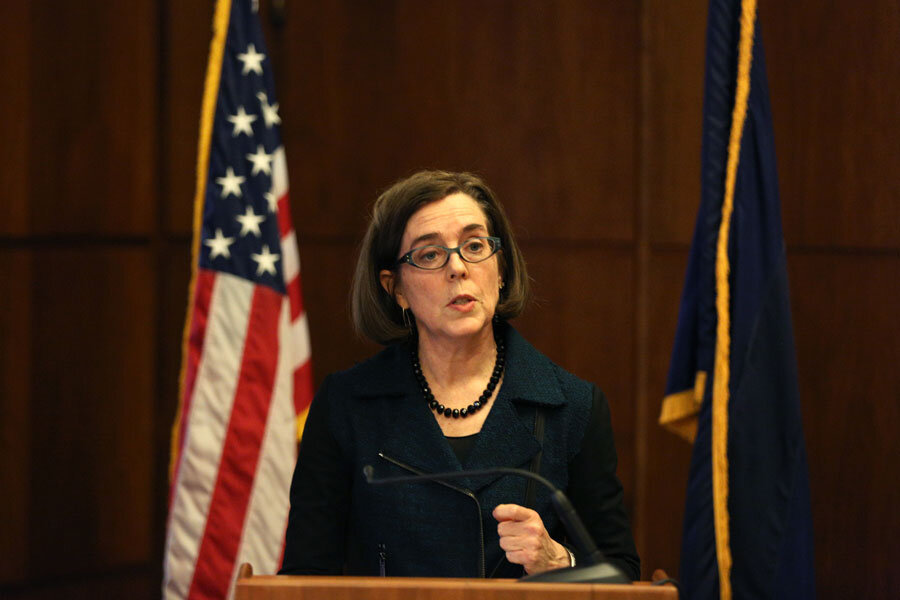What Oregon Gov. Brown and Ammon Bundy have in common
Loading...
Oregon Gov. Kate Brown called for an end to the occupation of Malheur National Wildlife Refuge by antigovernment protesters Wednesday, directing her frustration at the federal government.
“The residents of Harney County have been overlooked and underserved by federal officials’ response thus far,” said Governor Brown, despite her pleas to the US Department of Justice and the White House.
Led by Ammon Bundy, the protesters have occupied the wildlife refuge for three weeks in protest of two fellow ranchers imprisoned by federal authorities for arson and what they see as the lack of private lands for small farmers in the area.
“Federal authorities must move quickly to end the occupation and hold all of the wrongdoers accountable,” Brown said in a press conference Wednesday. “This spectacle of lawlessness must end. And until Harney County is free of it I will not stop insisting that federal officials enforce the law.”
Thursday 2 p.m. Update via Associated Press:
The FBI says its response to the occupation of a national wildlife refuge in Oregon by an armed group has been careful because authorities want to avoid violence.
In a statement Thursday the agency said the situation at the Malheur National Wildlife Refuge in eastern Oregon has caused "tremendous disruption and hardship" for people in the community and our "response has been deliberate and measured as we seek a peaceful resolution."
On Thursday, the armed group's leader went to the municipal airport in Burns, Oregon, close to where officials have set up a staging area. He says he spoke with federal authorities over the phone.
Bundy said his group is "not going to escalate" the situation, and he agreed to speak with authorities again Friday.
Enough is enough says Brown – it’s costing the state too much.
“In order to maintain public safety… multiple local law enforcement entities from around the state, as well as Oregon State Police Troopers, are coordinating with the Harney County sheriff to provide additional officers,” Kristen Grainger, Browns’ directors of communications, said in a statement. “The estimate of $100,000 a week represents the costs of labor, including overtime, travel reimbursement, lodging and meals for the officers.”
Brown says the occupation has cost Oregon taxpayers almost half a million dollars.
“We’ll be asking federal officials to reimburse the state for these costs,” she adds.
Harney County Judge Steve Grasty says Bundy isn’t getting the message: “It seems like he’s out of touch with reality.”
Bundy is from Arizona – not Oregon – and the community has made it clear that he needs to go home, said Grasty. The protest leader was present at a community meeting Tuesday night and he listened quietly as locals began chanting, “Go.”
Judge Grasty agrees with Brown’s sentiment about the federal government’s inaction. He suggests closing roads to the refuge so occupiers can’t come and go as they please.
But until the federal lands in Harney County are given to local residents – or there is a substantial plan to do so – the protesters have “no plans to leave,” says the group’s spokesman LaVoy Finicum.
Brown also shows conviction regarding a federal government response.
“This situation is absolutely intolerable and it must be resolved immediately,” she said at Wednesday’s news conference. "The very fabric of this community is being ripped apart."
As The Christian Science Monitor's Jessica Mendoza reported, since Waco and Ruby Ridge, law enforcement has learned to dial back its response, experts say. But, they note, that the Oregon takeover also suggests federal agencies have yet to find the “sweet spot” when it comes to dealing with armed protesters under siege.
“They clearly understand not to go in with guns ablaze,” says Richard White, a Stanford University professor of history who specializes in the American West. “I’m not sure what else they understand, though.”
In some ways, federal response to armed protests have shifted dramatically in the past two decades, experts say. In 1992, a confrontation between federal agents and Randy Weaver and his family at his home in northern Idaho ended in a shootout that resulted in the deaths of Mr. Weaver’s wife, Vicki, and 14-year-old son and Deputy US Marshal William Francis Degan.A year later, federal and state law enforcement agents laid siege to and then raided a compound in Waco, Texas, that belonged to the Branch Davidians, a religious group suspected of weapons violations. Nearly 80 people died in the ensuing gun battle.
In both cases, “there was an unwillingness to understand who the people were inside the building and what their concerns were,” says Catherine McNicol Stock, a historian and director of the American Studies program at Connecticut College in New London, Conn. “The idea is, if [law enforcement agents] had approached [these groups] taking their religious beliefs seriously, they might have been able to do something that wouldn’t have been the tragedy that happened.”
By contrast, not a single shot was fired during the standoff in 2014 between the federal Bureau of Land Management (BLM) and Cliven Bundy, who had refused to pay $1 million in grazing fees or recognize the government’s authority over the land, Reuters reported at the time. Instead – citing public safety, the BLM suspended its siege of Mr. Bundy’s ranch in Bunkerville, about 80 miles north of Las Vegas, and returned some of the animals already seized.
“The heavy-handed kind of actions that were at Ruby Ridge and Waco back in the '90s, people digging in their heels – that’s what you want to try to defuse,” says David Schanzer, director of the Triangle Center on Terrorism and Homeland Security at Duke University in North Carolina. “Taking the low-key approach, preventing more people from joining this protest is the way to go.”








